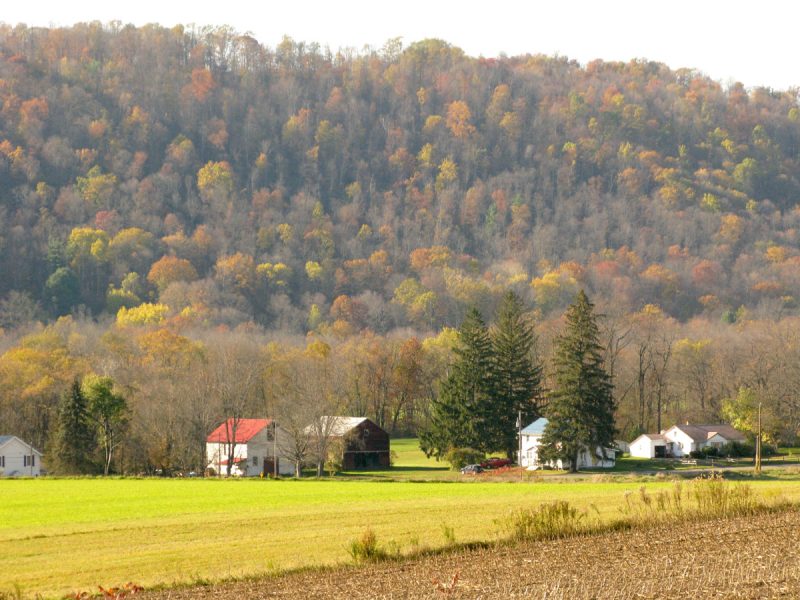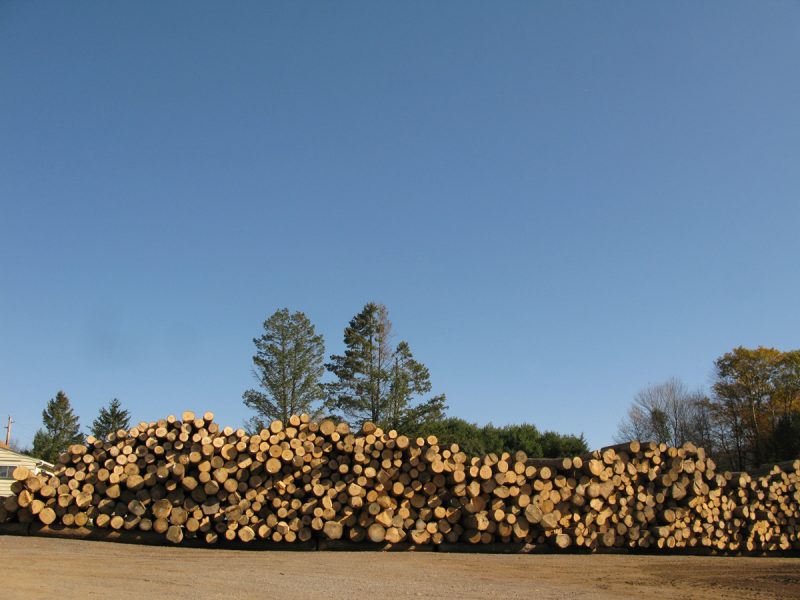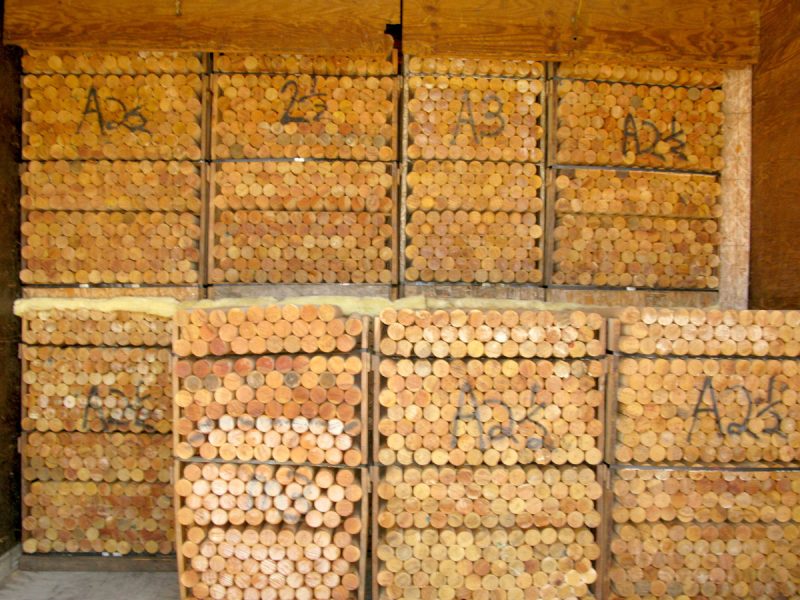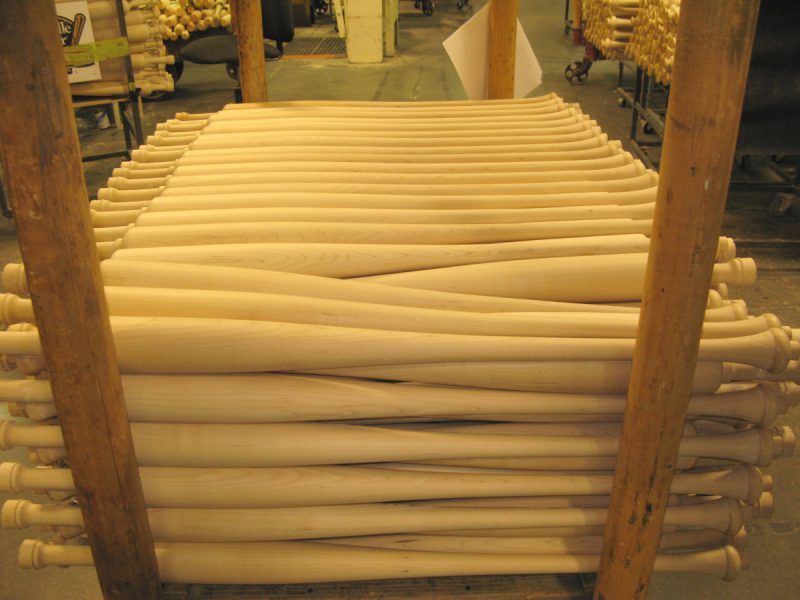HILLERICH & BRADSBY
In this extract from ‘The Man Who Made Things Out of Trees’, Rob visits a sawmill in Pennsylvania owned by the famous baseball bat manufacturer, Hillerich & Bradsby.
‘We prefer the smell of the ash. It’s a good smell. The ash is kind,’ Jeff Eckman, the sawmill manager said. Dressed in a peaked cap, a camouflage jacket, jeans and black, steel toe-capped boots, Jeff looked like a woodsman. He had been working at this mill since 1975, but he’d been involved in timber all his life. ‘I grew up on a farm right around here,’ Jeff said. ‘I’ve never gone far.’ He spoke slowly and with intimacy, often pausing between sentences to lift the peaked cap from his head with a lean hand, and reset it. He talked about the mechanization of the logging industry and how this has depleted the skills and knowledge of the loggers.
‘We prefer the smell of the ash. It’s a good smell. The ash is kind,’ Jeff Eckman, the sawmill manager said. Dressed in a peaked cap, a camouflage jacket, jeans and black, steel toe-capped boots, Jeff looked like a woodsman. He had been working at this mill since 1975, but he’d been involved in timber all his life. ‘I grew up on a farm right around here,’ Jeff said. ‘I’ve never gone far.’ He spoke slowly and with intimacy, often pausing between sentences to lift the peaked cap from his head with a lean hand, and reset it. He talked about the mechanization of the logging industry and how this has depleted the skills and knowledge of the loggers.
He reminded me a little of a character from the film The Deer Hunter. If Nick, played by Christopher Walken, hadn’t blown his head off playing Russian roulette in a gambling den in Saigon, he might have ended up working at a sawmill deep in the Allegheny Mountains.
Jeff recalled the time when Hillerich & Bradsby used to make ice hockey sticks and furniture parts, as well as baseball bats, all from ash. He told me how plenty of good ash went down the road to Jamestown, a national centre for furniture-making from the time the early Swedish settlers arrived with their woodworking skills, until twenty years ago. ‘It was high-end furniture but nobody wants that anymore. People buy plywood furniture and then when they move house, they throw it away. Nobody cares about the heritage anymore. Ah, it changes,’ Jeff said, staring out of the window of the sawmill office, towards the hills where the afternoon sunlight was slowly turning golden.
Jeff recalled the time when Hillerich & Bradsby used to make ice hockey sticks and furniture parts, as well as baseball bats, all from ash. He told me how plenty of good ash went down the road to Jamestown, a national centre for furniture-making from the time the early Swedish settlers arrived with their woodworking skills, until twenty years ago. ‘It was high-end furniture but nobody wants that anymore. People buy plywood furniture and then when they move house, they throw it away. Nobody cares about the heritage anymore. Ah, it changes,’ Jeff said, staring out of the window of the sawmill office, towards the hills where the afternoon sunlight was slowly turning golden.
‘We’ve tried pretty much every native timber to make baseball bats. We’ve tried aspen, black cherry, Northern red oak, hemlock, hickory, beech and birch. We make a few bats from birch now. A few years ago, we thought every bat would be made from either maple or birch by now. When the emerald ash borer hit, we thought the ash was done for.’
American scientists first officially identified the emerald ash borer (Agrilus planipennis Fairmaire), a green-winged, half-inch long, torpedo-shaped beetle, near Detroit, Michigan, in summer 2002. In 2003, the emerald ash borer was detected near Toledo, Ohio. By 2007, ash trees in Illinois, Indiana and Maryland were affected. At the beginning of 2010, the infestation covered an area of over 100,000 square miles across twelve states. By mid-2012, damage had been wrought in sixteen states of the USA and two Canadian provinces. In May 2013, the emerald ash borer arrived in the same New York county as Cooperstown, home to the National Baseball Hall of Fame.
American scientists first officially identified the emerald ash borer (Agrilus planipennis Fairmaire), a green-winged, half-inch long, torpedo-shaped beetle, near Detroit, Michigan, in summer 2002. In 2003, the emerald ash borer was detected near Toledo, Ohio. By 2007, ash trees in Illinois, Indiana and Maryland were affected. At the beginning of 2010, the infestation covered an area of over 100,000 square miles across twelve states. By mid-2012, damage had been wrought in sixteen states of the USA and two Canadian provinces. In May 2013, the emerald ash borer arrived in the same New York county as Cooperstown, home to the National Baseball Hall of Fame.
It is hard to comprehend the damage. Since its discovery, this voracious beetle has killed tens of millions of ash trees in North America and the havoc continues to mount. There are several theories on how the beetle was introduced into the USA: most likely, it arrived in a piece of wooden packing material commonly used to ship consumer goods from Asia, where tree species have co-evolved with the beetle over a long time and are resistant to it.
When I first read about the part ash has played in the story of the baseball bat, I wanted to visit the USA. I had initially hoped to carry a stave of my tree to the factory in Louisville, to be turned on a lathe into a beautiful bat. We don’t yet have the emerald ash borer in the UK, but I realized, reading about ‘the green menace’, that it would be insensitive to import a piece of ash, drive several thousand miles around the country with it in my car boot, and then take it home.
When I first read about the part ash has played in the story of the baseball bat, I wanted to visit the USA. I had initially hoped to carry a stave of my tree to the factory in Louisville, to be turned on a lathe into a beautiful bat. We don’t yet have the emerald ash borer in the UK, but I realized, reading about ‘the green menace’, that it would be insensitive to import a piece of ash, drive several thousand miles around the country with it in my car boot, and then take it home.
The deadly vigour of the emerald ash borer has, incidentally, allowed scientists in some fields to view the relationship between humans and trees in a new light. A US Department of Agriculture Forest Service survey of mortality rates in counties affected by the beetle noted an increase in the frequency of death by cardiovascular and lower respiratory tract illnesses. We should be cautious about reading too much into this, because the survey was small and controlling for demographic factors is complicated. However, it is a reminder that the concord between trees and human health is nuanced in many ways, ways that we often fail to acknowledge today, even though the likes of Henry David Thoreau were writing about them 150 years ago, and William Wordsworth sixty years before that.
Woodworkers use the term ‘figure’ to collectively describe the markings on the surfaces of wood. Figure is the result of a combination of all the anatomical features, from normal wood structure, including growth rings, to various abnormalities like knots. Generally, the more inconsistent the grain and the greater the frequency of abnormalities, the more pronounced the figure is. Figure comes in innumerable forms, many of which are distinctive and characteristic of particular tree species. Woodworkers have a delightful vocabulary of words and phrases to describe figure: ribbon, bird’s eye, flame, fiddleback, quilted, blistered, stripe, broken stripe and dimpling figure are just a few.
As we were talking about the emerald ash borer, Jeff opened a drawer in his desk and withdrew two leaflets and a laminated, luggage-label-size card. He glanced at them briefly and handed them to me. The card showed actual size photos of larvae and adult beetles. The leaflets contained information on the life cycle of the emerald ash borer and the symptoms of infestation of trees, as well as stern warnings about the movement of firewood.
‘Take ’em, Rob. You need to know all about it too. It’ll be in Britain some day soon, I guess. The authorities here did a good job getting information about the ash borer out. It first got down into southern Pennsylvania six years ago – and we thought then that there’d be no ash left here by now. No ash, huh? It was a big concern, but somehow it has not found its way into these woods, at least not yet,’ Jeff said, raising a hand towards the window and the silent forests beyond. ‘The ash borer can only fly about a half mile a year. As long as no one takes the beetle and drives it into the centre of the woods, then, you know . . . I’m more optimistic than I was, but can I sit here and say for sure that twenty years from now there’ll still be loads of ash round here? No, I can’t. It would be a terrible thing to lose it.’
There was a knock and the door to the office swung wide open. A glint-eyed, bright-faced lady in her seventies stood smiling at us. ‘You boys hiring?’ she said. Laughter cut through the still air and we rose to our feet. Jeff and I walked outside to the row of trucks parked on the grass beside the single-track road. The last, lambent light of the day was brushing the forest canopy on the far hills. The temperature had dropped; there was a hint of winter.
Jeff breathed deeply. He raised and reset his baseball cap again. ‘Right where we live here, right in this area, in the Allegheny Mountains and on the Appalachian plateau, this is not just where the best ash comes from, it’s where the best timber comes from. This is the best hardwood timber in the world. It’s why your people came here in the first place, Rob.’
Woodworkers use the term ‘figure’ to collectively describe the markings on the surfaces of wood. Figure is the result of a combination of all the anatomical features, from normal wood structure, including growth rings, to various abnormalities like knots. Generally, the more inconsistent the grain and the greater the frequency of abnormalities, the more pronounced the figure is. Figure comes in innumerable forms, many of which are distinctive and characteristic of particular tree species. Woodworkers have a delightful vocabulary of words and phrases to describe figure: ribbon, bird’s eye, flame, fiddleback, quilted, blistered, stripe, broken stripe and dimpling figure are just a few.
As we were talking about the emerald ash borer, Jeff opened a drawer in his desk and withdrew two leaflets and a laminated, luggage-label-size card. He glanced at them briefly and handed them to me. The card showed actual size photos of larvae and adult beetles. The leaflets contained information on the life cycle of the emerald ash borer and the symptoms of infestation of trees, as well as stern warnings about the movement of firewood.
‘Take ’em, Rob. You need to know all about it too. It’ll be in Britain some day soon, I guess. The authorities here did a good job getting information about the ash borer out. It first got down into southern Pennsylvania six years ago – and we thought then that there’d be no ash left here by now. No ash, huh? It was a big concern, but somehow it has not found its way into these woods, at least not yet,’ Jeff said, raising a hand towards the window and the silent forests beyond. ‘The ash borer can only fly about a half mile a year. As long as no one takes the beetle and drives it into the centre of the woods, then, you know . . . I’m more optimistic than I was, but can I sit here and say for sure that twenty years from now there’ll still be loads of ash round here? No, I can’t. It would be a terrible thing to lose it.’
There was a knock and the door to the office swung wide open. A glint-eyed, bright-faced lady in her seventies stood smiling at us. ‘You boys hiring?’ she said. Laughter cut through the still air and we rose to our feet. Jeff and I walked outside to the row of trucks parked on the grass beside the single-track road. The last, lambent light of the day was brushing the forest canopy on the far hills. The temperature had dropped; there was a hint of winter.
Jeff breathed deeply. He raised and reset his baseball cap again. ‘Right where we live here, right in this area, in the Allegheny Mountains and on the Appalachian plateau, this is not just where the best ash comes from, it’s where the best timber comes from. This is the best hardwood timber in the world. It’s why your people came here in the first place, Rob.’




